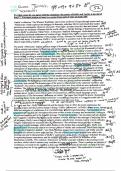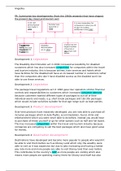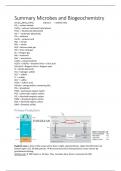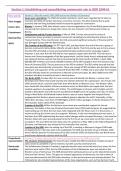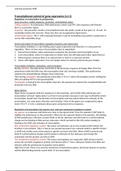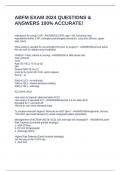International Trade and Investment
Summary of Lectures and Slides
University of Amsterdam
Chapter 1: Introduction
An important insight in international economics is that there are gains from trade: when
countries sell goods to each other it is (almost) always to their mutual benefit, even when
some of them is more efficient at producing everything and when producers in the less-
efficient countries compete by paying lower wages. However, it is possible that international
trade may hurt particular groups within nations and hence affect the income distribution.
International trade analysis, which is studied in this course, focuses primarily on the real
transactions in the international economy: transactions involving tangible commitments of
economic resources.
Chapter 2: World Trade
There is a strong empirical relationship between the size of a country’s economy (GDP) and
the volume of both imports and exports. When looking at world trade as a whole,
economists have found that an equation of the following form predicts the volume of trade
between any two countries fairly accurately:
#
𝑇!" = 𝐴 ∗ 𝑌! ∗ $ !
"!
A = constant 𝑌! = country i’s GDP
T = value of trade between country i and j 𝑌" = country j’s GDP
D = distance between two countries
The above equation is known as a gravity model of world trade, and states that the value of
trade between any two countries is (ceteris paribus) proportional to the product of the two
countries’ GDPs and diminishes with the distance between the two countries. One of the
main applications of the gravity model is that it helps to identify anomalies in trade.
All gravity models estimated by economists show a strong negative effect of distance on
international trade. This partly reflects increased costs of transporting goods and services to
countries that are further away. Also, economists use the gravity model to assess the impact
of trade agreements on actual international trade: if an agreement is effective it should lead
to significantly more trading among its partners than would otherwise be predicted using
the standard gravity model.
Clearly, advances in technology (internet, airlines, etc.) have made it easier to trade
internationally (although gravity models still show a clear negative relation between
distance and trade). However, history shows that political forces can outweigh the effects of
technology. The world trade dropped between 1840-1914 due to political measures but
increased again for much of the 20th century. In that sense, a global economy we know today
is not new, and there have been two great waves of globalization (the first relying on the
railroads and telegraph). Since the mid-20th century tough, world trade as a share of
production has risen to unprecedented levels.
1
Summary of Lectures and Slides
University of Amsterdam
Chapter 1: Introduction
An important insight in international economics is that there are gains from trade: when
countries sell goods to each other it is (almost) always to their mutual benefit, even when
some of them is more efficient at producing everything and when producers in the less-
efficient countries compete by paying lower wages. However, it is possible that international
trade may hurt particular groups within nations and hence affect the income distribution.
International trade analysis, which is studied in this course, focuses primarily on the real
transactions in the international economy: transactions involving tangible commitments of
economic resources.
Chapter 2: World Trade
There is a strong empirical relationship between the size of a country’s economy (GDP) and
the volume of both imports and exports. When looking at world trade as a whole,
economists have found that an equation of the following form predicts the volume of trade
between any two countries fairly accurately:
#
𝑇!" = 𝐴 ∗ 𝑌! ∗ $ !
"!
A = constant 𝑌! = country i’s GDP
T = value of trade between country i and j 𝑌" = country j’s GDP
D = distance between two countries
The above equation is known as a gravity model of world trade, and states that the value of
trade between any two countries is (ceteris paribus) proportional to the product of the two
countries’ GDPs and diminishes with the distance between the two countries. One of the
main applications of the gravity model is that it helps to identify anomalies in trade.
All gravity models estimated by economists show a strong negative effect of distance on
international trade. This partly reflects increased costs of transporting goods and services to
countries that are further away. Also, economists use the gravity model to assess the impact
of trade agreements on actual international trade: if an agreement is effective it should lead
to significantly more trading among its partners than would otherwise be predicted using
the standard gravity model.
Clearly, advances in technology (internet, airlines, etc.) have made it easier to trade
internationally (although gravity models still show a clear negative relation between
distance and trade). However, history shows that political forces can outweigh the effects of
technology. The world trade dropped between 1840-1914 due to political measures but
increased again for much of the 20th century. In that sense, a global economy we know today
is not new, and there have been two great waves of globalization (the first relying on the
railroads and telegraph). Since the mid-20th century tough, world trade as a share of
production has risen to unprecedented levels.
1


